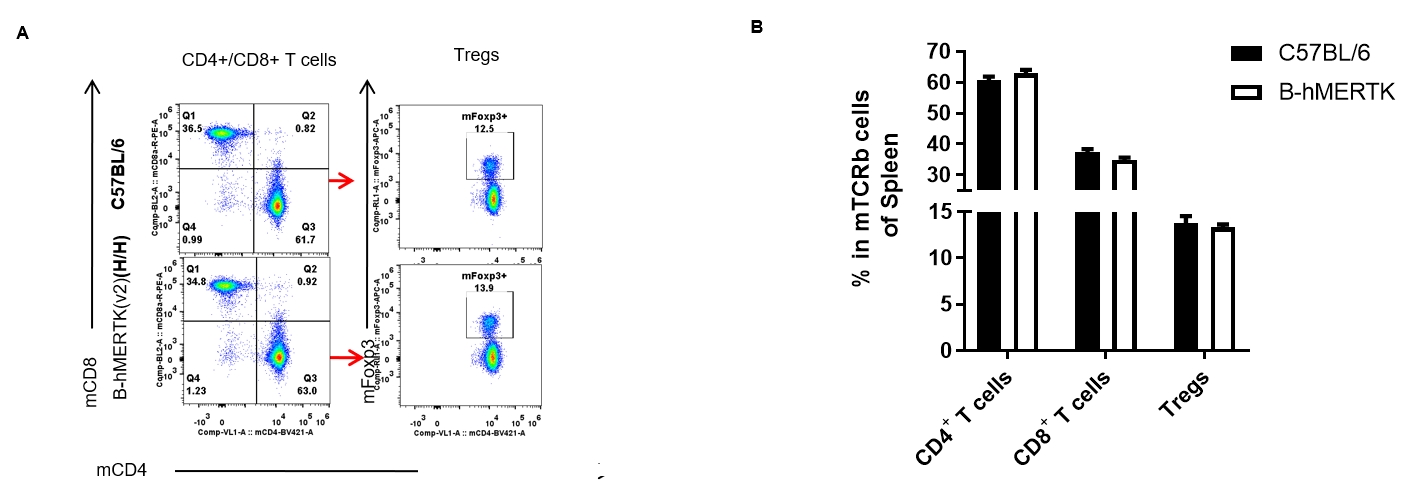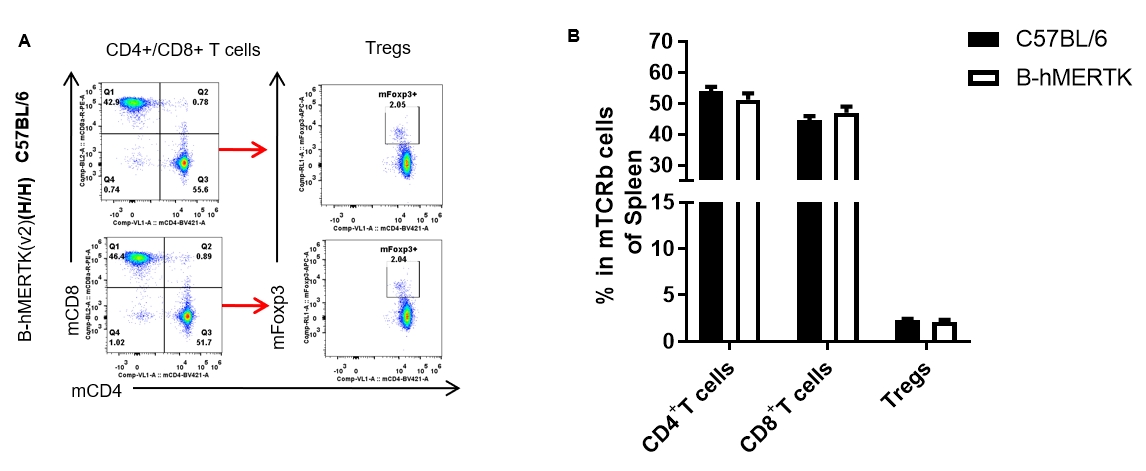Basic Information
-
Gene Targeting Strategy

-
Gene targeting strategy for B-hMERTK mice. The chimeric CDS contains human MERTK extracellular domain and mouse Mertk intracellular region was inserted into mouse Mertk gene in B-hMERTK mice. The insertion disrupts the endogenous murine Mertk gene, resulting in the absence of mouse transcripts.
-
mRNA expression analysis

-

Analysis of MERTK gene expression in wild-type mice and B-hMERTK mice by q-PCR. The mRNA expression of MERTK in B-hMERTK mice (H/H) was similar to those in the wild-type mice (+/+), demonstrating that introduction of hMERTK in place of its mouse counterpart does not change the expression level of MERTK mRNA.
-
Protein expression analysis

-
 Strain specific MERTK expression analysis in homozygous B-hMERTK mice by flow cytometry. Peritoneal washes were collected from wild-type C57BL/6 mice (+/+) and homozygous B-hMERTK mice (H/H). Flow cytometry analysis of the macrophage was analyzed with species-specific anti-MERTK antibody. Mouse MERTK was detectable in wild-type mice. Human MERTK was only detectable in homozygote B-hMERTK mice but not in wild-type mice.
Strain specific MERTK expression analysis in homozygous B-hMERTK mice by flow cytometry. Peritoneal washes were collected from wild-type C57BL/6 mice (+/+) and homozygous B-hMERTK mice (H/H). Flow cytometry analysis of the macrophage was analyzed with species-specific anti-MERTK antibody. Mouse MERTK was detectable in wild-type mice. Human MERTK was only detectable in homozygote B-hMERTK mice but not in wild-type mice. -
Analysis of spleen immune cells

-

Analysis of spleen leukocyte subpopulations by FACS. Splenocytes were isolated from male C57BL/6 and B-hMERTK mice(n=3, 7-week-old). Flow cytometry analysis of the splenocytes was performed to assess leukocyte subpopulations. A. Representative FACS plots. Single live cells were gated for the CD45+ population and used for further analysis as indicated here. B. Results of FACS analysis. Percent of NK cells, dendritic cells, granulocytes, monocytes and macrophages in homozygous B-hMERTK mice were similar to those in the C57BL/6 mice, demonstrating that B-hMERTK humanized does not change the overall development, differentiation or distribution of these cell types in spleen. Values are expressed as mean ± SEM.
-
Analysis of T cell subpopulation in spleen

-

Analysis of spleen T cell subpopulations by FACS. Splenocytes were isolated from male C57BL/6 and B-hMERTK mice(n=3, 7-week-old). Flow cytometry analysis of the splenocytes was performed to assess leukocyte subpopulations. A. Representative FACS plots. Single live CD45+ cells were gated for T cell population and used for further analysis as indicated here. B. Results of FACS analysis. The percent of CD8+ T cells, CD4+ T cells, and Tregs in homozygous B-hMERTK mice were similar to those in the C57BL/6 mice, demonstrating that introduction of B-hMERTK in place of its mouse counterpart does not change the overall development, differentiation or distribution of these T cell subtypes in spleen. Values are expressed as mean ± SEM.
-
Analysis of leukocytes cell subpopulation in lymph node

-

Analysis of lymph node leukocyte subpopulations by FACS. Leukocytes were isolated from male C57BL/6 and B-hMERTK mice(n=3, 7-week-old) Flow cytometry analysis of the leukocytes was performed to assess leukocyte subpopulations. A. Representative FACS plots. Single live cells were gated for CD45+ population and used for further analysis as indicated here. B. Results of FACS analysis Percent of T cells, B cells, NK cells, in homozygous B-hMERTK mice were similar to those in the C57BL/6 mice, demonstrating that introduction of B-hMERTK in place of its mouse counterpart does not change the overall development, differentiation or distribution of these cell types in lymph node. Values are expressed as mean ± SEM.
-
Analysis of T cell subpopulation lymph node

-

Analysis of lymph node leukocyte subpopulations by FACS. Leukocytes were isolated from male C57BL/6 and B-hMERTK mice(n=3, 7- week-old) Flow cytometry analysis of the leukocytes was performed to assess leukocyte subpopulations. Representative FACS plots. Single live CD45+ cells were gated for TCRb+ T cell population and used for further analysis as indicated here. B. Results of FACS analysis. The percent of CD8+ T cells, CD4+ T cells in homozygous B-hMERTK mice were similar to those in the C57BL/6 mice, demonstrating that introduction of B-hMERTK in place of its mouse counterpart does not change the overall development, differentiation or distribution of these cell types in lymph node. Values are expressed as mean ± SEM.
-
Analysis of leukocytes cell subpopulation in blood

-

Analysis of blood leukocyte subpopulations by FACS. Leukocytes were isolated from male C57BL/6 and B-hMERTK mice(n=3, 7-week-old) Flow cytometry analysis of the leukocytes was performed to assess leukocyte subpopulations. A. Representative FACS plots. Single live cells were gated for CD45+ population and used for further analysis as indicated here. B. Results of FACS analysis Percent of T cells, B cells, NK cells, dendritic cells, granulocytes, monocytes and macrophages in homozygous B-hMERTK mice were similar to those in the C57BL/6 mice, demonstrating that introduction of B-hMERTKin place of its mouse counterpart does not change the overall development, differentiation or distribution of these cell types in blood. Values are expressed as mean ± SEM.
-
Analysis of T cell subpopulation in blood

-

Analysis of blood leukocyte subpopulations by FACS. Leukocytes were isolated from male C57BL/6 and B-hMERTKmice(n=3, 7-week-old) Flow cytometry analysis of the leukocytes was performed to assess leukocyte subpopulations. Representative FACS plots. Single live CD45+ cells were gated for TCRb+ T cell population and used for further analysis as indicated here. B. Results of FACS analysis. The percent of CD4+, CD8+, Tregs in homozygous B-hMERTK mice were similar to those in the C57BL/6 mice, demonstrating that introduction of B-hMERTKin place of its mouse counterpart does not change the overall development, differentiation or distribution of these cell types in blood. Values are expressed as mean ± SEM.
-
Summary

-
mRNA expression analysis:
The mRNA expression of MERTK in B-hMERTK (H/H) was similar to those in the wild-type mice (+/+), demonstrating that introduction of hMERTK in place of its mouse counterpart does not change the expression level of MERTK mRNA.
Protein expression analysis:
Mouse MERTK was detectable in wild-type mice. Human MERTK was only detectable in homozygote B-hMERTK mice but not in wild-type mice.
Leukocytes cell subpopulation analysis:
MERTK humanized does not change the overall development, differentiation or distribution of immune cell types in spleen, thymus and blood.


